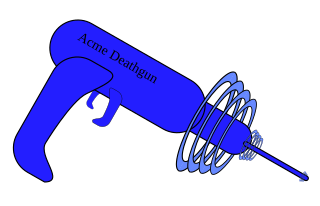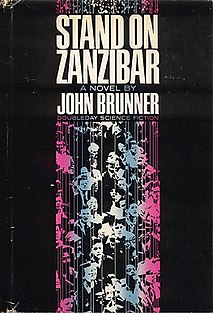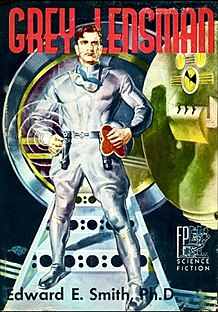
"Third from the Sun" is episode 14 of the American television anthology series The Twilight Zone. It is based on a short story of the same name by Richard Matheson which first appeared in the first issue of the magazine Galaxy Science Fiction in October 1950.

The Years of Rice and Salt is an alternate history novel by American science fiction author Kim Stanley Robinson, published in 2002. The novel explores how world history might have been different if the Black Death plague had killed 99% of Europe's population, instead of a third as it did in our modern reality. Divided into ten parts, the story spans hundreds of years, from the army of the Muslim conqueror Timur to the 21st century, with Europe being re-populated by Muslim pioneers, the indigenous peoples of the Americas forming a league to resist Chinese and Muslim invaders, and a 67-year-long world war being fought primarily between Muslim states and the Chinese and their allies. While the ten parts take place in different times and places, they are connected by a group of characters that are reincarnated into each time but are identified to the reader by the first letter of their name being consistent in each life.

Strange and exotic weapons are a recurring feature in science fiction. In some cases, weapons first introduced in science fiction have been made a reality; other science fiction weapons remain purely fictional, and are often beyond the realms of known physical possibility.

Stand on Zanzibar is a dystopian New Wave science fiction novel written by John Brunner and first published in 1968. The book won a Hugo Award for Best Novel at the 27th World Science Fiction Convention in 1969, as well as the 1969 BSFA Award and the 1973 Prix Tour-Apollo Award.

Timescape is a 1980 science fiction novel by American writer Gregory Benford. It won the 1981 Nebula and 1980 British Science Fiction Award, and the 1981 John W. Campbell Memorial Award for Best Science Fiction Novel. It won the 1981 Ditmar Award for Best International Fiction. The novel was widely hailed by both critics of science fiction and mainstream literature for its fusion of detailed character development and interpersonal drama with more standard science fiction fare such as time travel and ecological issues.

Fantastic Voyage II: Destination Brain is a science fiction novel by American writer Isaac Asimov, published in 1987. It is about a group of scientists who shrink to microscopic size in order to enter a human brain so that they can retrieve memories from a comatose colleague.

State of Fear is a 2004 techno-thriller novel by Michael Crichton, his fourteeth under his own name and twenty-fourth overall, in which eco-terrorists plot mass murder to publicize the danger of global warming. Despite being a work of fiction, the book contains many graphs and footnotes, two appendices, and a 20-page bibliography in support of Crichton's beliefs about global warming. Many climate scientists, science journalists, environmental groups, and science advocacy organisations dispute Crichton's views on the science as being error-filled and distorted.
Hyperspace is a concept from science fiction relating to a superluminal method of travel. It is typically described as an alternative "sub-region" of space co-existing with our own universe which may be entered using an energy field or other device. In most fiction, hyperspace is described as a physical place that can be entered and exited. Once in hyperspace, the laws of general and special relativity do not behave in the same way when compared to normal outer space, allowing travelers though hyperspace to go great distances without being physically present in normal space and taking less time, measured from normal outer space, to travel said distance. "Through hyper-space, that unimagineable region that was neither space nor time, matter nor energy, something nor nothing, one could traverse the length of the Galaxy in the interval between two neighboring instants of time." Hyperspace is a part of the universe where time can be traveled just like normal space's distance. This allows faster-than-light travel which is necessary to have practical outer space travel.

The Institute for Defense Analyses (IDA) is an American non-profit corporation that administers three federally funded research and development centers (FFRDCs) – the Systems and Analyses Center (SAC), the Science and Technology Policy Institute (STPI), and the Center for Communications and Computing (C&C) – to assist the United States government in addressing national security issues, particularly those requiring scientific and technical expertise. It is headquartered in Alexandria, Virginia.
The military funding of science has had a powerful transformative effect on the practice and products of scientific research since the early 20th century. Particularly since World War I, advanced science-based technologies have been viewed as essential elements of a successful military.
A fix-up is a novel created from several short fiction stories that may or may not have been initially related or previously published. The stories may be edited for consistency, and sometimes new connecting material, such as a frame story or other interstitial narration, is written for the new work. The term was coined by the science fiction writer A. E. van Vogt, who published several fix-ups of his own, including The Voyage of the Space Beagle, but the practice exists outside of science fiction. The use of the term in science fiction criticism was popularised by the first (1979) edition of the Encyclopedia of Science Fiction, edited by Peter Nicholls, which credited van Vogt with the creation of the term. The name comes from the modifications that the author needs to make in the original texts to make them fit together as though they were a novel. Foreshadowing of events from the later stories may be jammed into an early chapter of the fix-up, and character development may be interleaved throughout the book. Contradictions and inconsistencies between episodes are usually worked out.

Die Glocke was a purported top secret Nazi scientific technological device, secret weapon, or Wunderwaffe. First described by Polish journalist and author Igor Witkowski in Prawda o Wunderwaffe (2000), it was later popularized by military journalist and author Nick Cook who associated it with Nazi occultism, antigravity and free energy research. Mainstream reviewers have criticized claims about Die Glocke as being pseudoscientific, recycled rumors, and a hoax. Die Glocke and other alleged Nazi "miracle weapons" have been dramatized in video games, television shows, and novels.

Starman's Quest is a science fiction novel by American writer Robert Silverberg. It was published in 1958 by Gnome Press in an edition of 5,000 copies, of which only 3,000 were bound. It was reprinted as a second edition in hardcover by Meredith Press in 1969.

Gray Lensman is a science fiction novel by American writer E. E. Smith. It was first published in book form in 1951 by Fantasy Press in an edition of 5,096 copies. The novel was originally serialized in the magazine Astounding in 1939. Gray Lensman is the fourth book in the Lensman series and the second to focus on the adventures of Lensman Kimball Kinnison.

Empire of the Atom is a science fiction novel by Canadian American writer A. E. van Vogt. It was first published in 1957 by Shasta Publishers in an edition of 2,000 copies. The novel is a fix-up of the first five of van Vogt's Gods stories which originally appeared in the magazine Astounding. The remaining Gods stories are collected in The Wizard of Linn. Author and critic James Blish observed that the plot of the Gods stories resembled that of Robert Graves' Claudius novels. Author and critic Damon Knight said that the plot was "lifted almost bodily" from the plot of I, Claudius. A genealogy chart of the ruling family of the Empire of Linn is included.
The death ray or death beam was a theoretical particle beam or electromagnetic weapon first theorized around the 1920s and 1930s. Around that time, notable inventors such as Guglielmo Marconi, Nikola Tesla, Harry Grindell Matthews, Edwin R. Scott, Erich Graichen and others claimed to have invented it independently. In 1957, the National Inventors Council was still issuing lists of needed military inventions that included a death ray.

The War of the Worlds is a science fiction novel by English author H. G. Wells, first serialised in 1897 by Pearson's Magazine in the UK and by Cosmopolitan magazine in the US. The novel's first appearance in hardcover was in 1898 from publisher William Heinemann of London. Written between 1895 and 1897, it is one of the earliest stories to detail a conflict between mankind and an extraterrestrial race. The novel is the first-person narrative of both an unnamed protagonist in Surrey and of his younger brother in London as southern England is invaded by Martians. The novel is one of the most commented-on works in the science fiction canon.

Devil's Gate is an adventure novel in author Clive Cussler's The NUMA Files. Co-written with Graham Brown, this installment is the ninth of that series which features the main character Kurt Austin. The story follows employees of NUMA who discover someone is developing a directed-energy weapon and thwart the dictator of Sierre Leone, Djemma Garand, and the mercenary group led by Andras the Knife before they are able to use the weapon. The hardcover edition was released November 14, 2011, it was subsequently released as a paperback, audiobook and ebook. It appeared on several best-seller lists and was describe by reviewers as being suitable for fans of Cussler and action-adventure stories.

Starship Through Space is a science-fiction novel written by G. Harry Stine under the pseudonym Lee Correy. It was published in 1954 by Henry Holt and Company. The book tells the story of the building of the first starship and of its flight to Alpha Centauri.
Biological warfare (BW)—also known as bacteriological warfare, or germ warfare—has had a presence in popular culture for over 100 years. Public interest in it became intense during the Cold War, especially the 1960s and '70s, and continues unabated. This article comprises a list of popular culture works referencing BW or bioterrorism, but not those pertaining to natural, or unintentional, epidemics.















